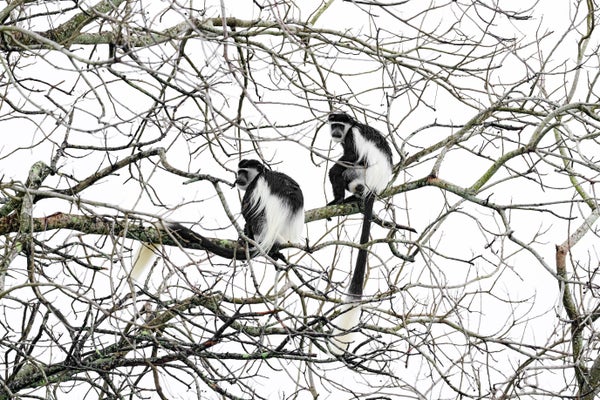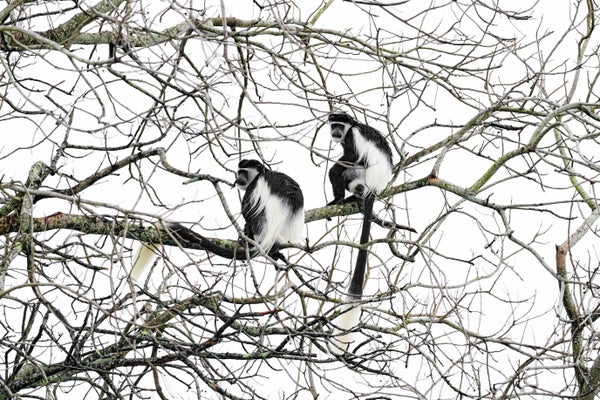How Ugandan Tobacco Farming Inadvertently Threatens Spread of Bat-Borne Viruses
By cutting trees in response to international demand for tobacco, farmers induced wildlife to start eating virus-laden bat guano

Black and white Colobus monkeys in Uganda have been seen eating bat guano loaded with viruses.
Ondrej Prosicky/Alamy Stock Photo
Zoonotic diseases, or illnesses transmitted from animals to humans, account for about three quarters of new infectious diseases around the world, including some that could lead to pandemics. The risk of a pathogen jumping from an animal to a human increases when people encroach on ecosystems and cause relationships to be disrupted between species—but how that risk actually becomes a reality can be unpredictable and difficult to untangle.
A new paper published this week in Communications Biology shines rare light on one such case study: an example showing how international demand for tobacco led to habitat alterations in Uganda that seemingly drove chimpanzees and other species to begin consuming bat guano for mineral nutrients. In that process, the animals might have been exposed to more than two dozen viruses, including a novel cousin of the COVID-causing pathogen SARS-CoV-2.
“This is the butterfly effect of infectious disease ecology,” says senior study author Tony Goldberg, a wildlife epidemiologist at the University of Wisconsin–Madison. “Far-flung events like demand for tobacco can have crazy, unintended consequences for disease emergence that follow pathways that we rarely see and can’t predict.”
On supporting science journalism
If you’re enjoying this article, consider supporting our award-winning journalism by subscribing. By purchasing a subscription you are helping to ensure the future of impactful stories about the discoveries and ideas shaping our world today.
Goldberg and his colleagues’ study focuses on human and ecological interactions in the Budongo Forest Reserve in western Uganda. The first hint the team had that something strange was going on was when their collaborators in Uganda noticed chimpanzees gathering at a large, hollow tree and eating something from within it. Upon closer inspection, the field researchers realized the chimps were consuming bat guano, which had been deposited by a colony of Noack’s roundleaf bats that were roosting in the hollowed-out tree.
Although researchers had been observing chimpanzees in Budongo for decades, none had ever seen or heard of anything like this before. So Goldberg and his colleagues set up field cameras by the tree. Videos they collected between 2017 and 2019 revealed 839 instances of guano consumption, not only by chimpanzees but also by black-and-white colobus monkeys and red duikers, a type of forest antelope.
Bat guano isn’t the only seemingly odd thing that field staff and scientists at Budongo have observed chimpanzees and other wildlife eating. Chimps will also sometimes eat clay, for example, or termite mounds. The reason, researchers have found, is that animals living in Budongo, like those in many tropical ecosystems, face a scarcity of dietary minerals.
So when the bat guano observations came to light, Goldberg and others immediately thought it must be connected to diet. Because animals had never been observed eating guano before, however, the researchers figured that something in the environment must have changed. The story that emerged was more complex than they imagined—and hinged on the disappearance of a specific palm tree, Raphia farinifera.
In years past chimpanzees and other animals were often observed eating the decaying wood of fallen R. farinifera palms, which they sought out for minerals. But between 2006 and 2012 tobacco farming increased in the area. Local farmers began cutting down R. farinifera to use the tree’s tough, peelable fronds to make strings on which to hang tobacco leaves to dry. Demand was so high that R. farinifera nearly disappeared from Budongo altogether.
“That eliminated the primary source of minerals for animals, so they had to fall back on other sources,” Goldberg says. Bat guano, it turned out, was a great alternative. The researchers do not know how the chimpanzees and other animals knew to seek out guano, yet tests they ran confirmed the material is high in sodium, potassium, magnesium and phosphorus.
Because this was bat guano, though, Goldberg and his colleagues also wanted to test for viruses. “Bats are wonderful creatures; we love them. But they do carry viruses,” Goldberg says. “We wanted to know what else the chimpanzees might be getting from this bat guano.”
Tests of 11 guano samples collected from the hollow tree over eight months in 2018 and 2019 revealed 27 different viruses, including a novel coronavirus that’s the equivalent of “a first cousin” to SARS-CoV-2, Goldberg says. Analyses the researchers ran to try to predict whether the novel coronavirus might be able to infect people came back as inconclusive because the new pathogen appears to latch on to cells in a different way than SARS-CoV-2 does. “We don’t know enough about this flavor of coronavirus to predict what it could infect,” Goldberg says.
“The overarching theme of anthropogenic drivers causing ecological changes that could result in pathogenic viral spillover is very real, and this paper highlights an additional, intriguing way through which this might happen,” says Rebekah Kading, a microbiologist at Colorado State University, who was not involved in the research. “While this potential spillover pathway is still hypothetical, it is important to recognize situations such as this one in which the public health consequences could be significant, while the potential solution to mitigating this threat could be as simple as offering farmers materials for binding tobacco leaves to reduce the pressure on the R. farinifera tree.”
The new study raises additional questions, including how widespread the phenomenon of chimpanzees and other species eating bat guano might be. All of the observations came from the single tree, but Goldberg guesses that there are likely other instances of the behavior that are happening elsewhere in Budongo and other mineral-poor ecosystems around the world. He also wonders whether guano consumption might eventually be shown to be tied to the mystery of Ebola viruses’ origins.
Many scientists suspect that bats might serve as the natural host for Ebola viruses, and chimpanzees, red duikers and black-and-white colobus monkeys are all species that have been implicated in various Ebola outbreaks after humans have come into contact with them. “This paper could help lift the veil over a mystery that’s plagued disease ecology for decades: How do wild animals like chimpanzees contract Ebola viruses, probably from bats, in the wild?” Goldberg says. “It’s a lucky example of pulling back the curtain and seeing a series of hidden events that could be preceding outbreaks.”

